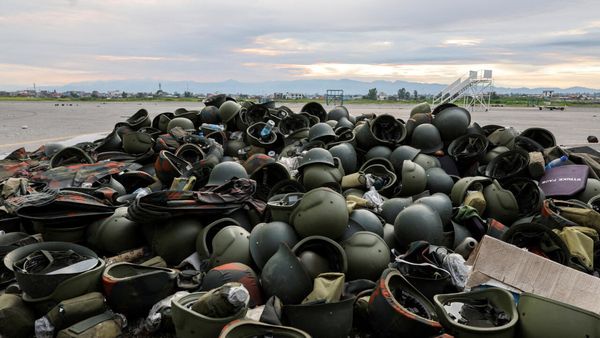
Some say Shakespeare invented the “history play” – but he had a lot of help.
Shakespeare was mainly writing comedies in the early 1590s when he is believed to have coauthored the play we now call Henry VI Part 2 with Christopher Marlowe and others.
Following the commercial success of this play and its coauthored sequel, Henry VI Part 3, a rival theatre company wrote a prequel play we now call Henry VI Part 1. Studies suggest Shakespeare was never a primary author of this play, but he did contribute to it later.
As previous coauthors died, all three Henry VI plays fell into Shakespeare’s lap by 1595, and he was tasked with editing all three plays together as a trilogy (or a tetralogy, with his Richard III).
After the success of this first tetralogy, Shakespeare reached further back in time to write Richard II, followed by the two Henry IV plays, then Henry V.
By 1599, Shakespeare had two tetralogies to his name (or two “Henriads”, as Shakespeare scholars dub them), dramatising the hundred-odd years, and various reigns, between Richard II and Richard III (1377–1485).
These eight plays have now been stitched together by director Damien Ryan as The Player Kings, which can be watched over two nights or as one performance lasting from 11:30am to 11:00pm.
This is binge-worthy Shakespeare, stupendously absorbing and exquisitely realised.
A modern history
Ryan begins in the 1950s, before evolving to catch up with contemporary times when we see a sniper drone launched against Richard III. Lily Moody and Ruby Jenkins’ stylish costumes lend a sense of chronology to the historical plights.
Richard II is elegantly 1950s, but the wayward Prince Hal channels 1960s Mick Jagger. Jack Cade’s rebellion in Henry VI is working-class 80s (one character wears a Back to the Future t-shirt). The devilish Richard III is cool black leathered nonchalance.

Ryan is a master of delighting his audiences by delivering Shakespeare’s lines faithfully with unexpected visual scenarios. In Richard II, the king and queen partake in a royal photo shoot. This segues into a scenario where technicians develop the black and white photos under red lights, all the while speaking Shakespeare’s lines.
In a sequence from Henry VI, the blue and white tiles of the court transform into a shimmering pool for a languid pool party. Ryan praises Shakespeare in the program for letting “his form match his content, which is the very point of poetry”. Ryan also achieves this with his exciting direction.
Kate Beere’s dynamic and malleable set combines a grassy knoll with other green spaces and a tiled court centre stage, joined to a rutted cement staircase and backed by a windowed entrance. This doubles as a screen for historical footage of 20th century social upheavals, with video design from Aron Murray. News cameras are brought onstage to project live footage of a monarch’s “comms” with the populace, a place where egos and diplomacy clash.
Perched atop all this is the musical nest of composer Jack Mitsch, who plays guitars and drums underpinning the drama.
Brilliantly performed
The acting is second to none. Sean O’Shea gives a mesmerising performance as Richard II, a flippant self-centred king genuinely attached to his favourites.
Katrina Retallick’s Queen Isabel is vibrant and assured. Longstanding doyens of Australian theatre, Peter Carroll and John Gaden, are paired up as the two gardeners.
Gareth Davies as the banished, but soon-to-be usurping Henry Bolingbroke plays a psychological game as he slowly wrests the crown from Richard, prompted more by political survival than ordained succession. Christopher Stollery is controlled, astute and forceful as Northumberland.

Ryan’s casting of his two young sons in Henry IV is inspired. Oliver Ryan performing Prince Hal and Max Ryan as Harry Hotspur adds poignancy to these rivals who must duel each other to the death.
The Boar’s Head Tavern becomes a 60s “lock-in” of counterculture mayhem, with Emma Palmer delivering a superbly stoned Doll Tearsheet. Steve Rodgers’ Falstaff is raw and straight from the pub, licentious to the max, and prone to mooning the crowd. Lulu Howes’ wild Lady Hotspur yearns for her distracted husband’s attention. Andrew Cutcliff gives a thundering and manly impression of King Henry V.
The rarely performed Henry VI plays are fused together in an embroiling dynastic power-play. Outstanding performances include Davies as a delicate King Henry VI, unschooled in the vicious brutalities of monarchical contest, and Henaway as a commanding Joan of Arc.

As civil strife erupts between the “white-rosed” Lancastrians and the “red-rosed” Yorkists, we see the early rise of “that valiant crook-back prodigy”, Richard of Gloucester (Gamble), who murders his way to becoming King Richard III. In that final play, Palmer gives a vociferous Margaret of Anjou.
Glued to the action
Eight plays delivered in two 4.5 hour sessions, and yet Sport for Jove is mindful of audience comforts. Each session has two intermissions and most blocks run less than 90 minutes. The acting and dynamism on stage works so well that the crowd I attended with was glued to the action from first word to last, 12 hours later.
While Shakespeare made history with these plays, The Player Kings becomes history in the making: a landmark Australian production.
The Player Kings from Sport for Jove is at the Seymour Centre, Sydney, until April 5.
Kirk Dodd does not work for, consult, own shares in or receive funding from any company or organisation that would benefit from this article, and has disclosed no relevant affiliations beyond their academic appointment.
This article was originally published on The Conversation. Read the original article.







